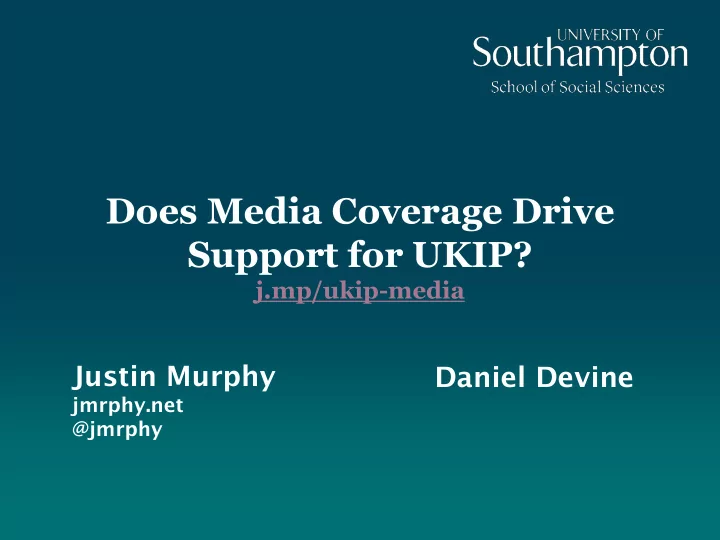

Does Media Coverage Drive Support for UKIP? j.mp/ukip-media Justin Murphy Daniel Devine jmrphy.net @jmrphy
Overview 1. Motivation, background and hypotheses 2. Data and methods 3. Findings 4. Conclusion
“The level of support for UKIP exhibited in the opinion poll data for England and Wales has been growing steadily for a number of years.”
• Media visibility of right-wing political parties has a positive effect on their support (Boomgaarden and Vliegenthart, 2007; Vliegenthart et al, 2012). • There is some debate: Pauwels (2010) completely disputes a causal connection . Alternatively, Rooduijn (2014) and Deacon and Wring (2015) argue that electoral success drives coverage. • It may be that the coverage-political support nexus is different in different political systems, or that the relationship is different for UKIP in particular.
Hypotheses H1: Increases in media coverage lead to increased public support, controlling for previous levels of public support and previous levels of media coverage H2: Increases in public support lead to increased media coverage, controlling for previous levels of media coverage and previous levels of public support.
Data and Method • ‘Public support’ is measured by monthly polling on vote intentions by Ipsos MORI between January 2004 and September 2015. • ‘Media coverage’ is measured by the monthly count of articles mentioning ‘UKIP’ or ‘UK Independence Party’ from all national newspapers over the same time period, using the database Nexis. This resulted in 65,416 articles. • We control for General and European elections by including them as binary variables (1 if election occurred in that month, 0 otherwise).
Data and Method Quantitative Analysis • We use vector auto-regression (VAR) with Granger causality tests to test the hypotheses quantitatively. Qualitative Analysis • A brief historical qualitative analysis of the period under study to understand what was actually going on in British politics at the time
Findings (Articles, Support)
Findings • There is statistically significant evidence (p: 0.037) that media coverage drives public support (hypothesis 1) but: • There is no evidence that changes in public support predict media coverage (hypothesis 2).
Findings
Findings There were two substantively significant increases in support which preclude and are unrelated to change in polls: 1. July to September, 2012 Media coverage for UKIP spikes despite stagnating then decreasing support. This continues until January 2013, when UKIP support spikes and continues on an upward trajectory. 2. November 2013 Despite poll ratings being at their lowest for the entire year, media coverage increases and is followed by a sustained increase in both series for a year.
Findings
Conclusion • We find qualified evidence that the media did independently generate support for UKIP over the time period under study; • Our results support previous findings in other political systems (such as the Netherlands, Belgium and Germany), supporting the generalisability of this finding; • We illustrate the substantive nature of these dynamics with a brief qualitative analysis of specific events; • We have contributed to a contemporary policy debate in the UK revolving around the regulation of media.
Conclusion – Future work As with all studies, there are some limitations. Future work could consider: • Content analysis on the newspaper coverage used here. • Expanding the sample beyond print media • Understanding leader effects • Issue linkage?
Recommend
More recommend